Abstract
The rapid integration of the Internet of Medical Things (IoMT) is transforming healthcare through real-time monitoring, AI-driven diagnostics, and remote treatment. However, the growing reliance on IoMT devices, such as robotic surgical systems, life-support equipment, and wearable health monitors, has expanded the attack surface, exposing healthcare systems to cybersecurity risks like data breaches, device manipulation, and potentially life-threatening disruptions. While 6G networks offer significant benefits for healthcare, such as ultra-low latency, extensive connectivity, and AI-native capabilities, as highlighted in the ITU 6G (IMT-2030) framework, they are expected to introduce new and potentially more severe security challenges. These advancements put critical medical systems at greater risk, highlighting the need for more robust security measures. This study leverages AI techniques to systematically identify security vulnerabilities within 6G-enabled healthcare environments. Additionally, the proposed approach strengthens AI-driven security through use of multiple XAI techniques cross-validated against each other. Drawing on the insights provided by XAI, we tailor our mitigation strategies to the ITU-defined 6G usage scenarios, with a focus on their applicability to medical IoT networks. We propose that these strategies will effectively address potential vulnerabilities and enhance the security of medical systems leveraging IoT and 6G networks.
1. Introduction
Advancements in wireless communication have revolutionized healthcare, enabling innovations like surgical robotics, real-time remote monitoring, and XR (extended reality)-assisted treatments, benefiting rural, remote, and emergency care [,]. The rise of the Internet of Medical Things (IoMT) has further improved patient care through continuous data access, supporting timely interventions and personalized treatments []. Future 6G networks are expected to accelerate these advancements with ultra-low latency, massive device connectivity, and seamless AI and edge cloud integration. According to the ITU-R M.2160 framework, 6G will enable network-wide AI integration, multi-access edge computing (MEC), enhanced XR, and integrated sensing and communication for more efficient, intelligent, and responsive real-time patient care [,].
These advancements brought by the integration of 6G networks in healthcare are anticipated to introduce substantial security challenges. The incorporation of sensing, edge computing, and cloud services expands the attack surface, putting critical medical devices like cardiac monitors, infusion pumps, and respirators at risk from both internal and external threats []. Introducing AI further exposes healthcare systems to adversarial and model poisoning attacks, endangering patient safety []. Additionally, immersive technologies, such as AR-assisted surgeries, introduce new vulnerabilities, offering potential entry points for unauthorized access [,]. The fragmented management of edge and cloud infrastructures increases system vulnerabilities, making it more challenging to maintain data integrity []. As 6G networks integrate with public land mobile networks (PLMNs), traditional threats like DDoS, MiTM attacks, and SYN floods will intensify, alongside more sophisticated attacks []. The rapid growth of IoMT devices, edge nodes, and real-time data streams adds risks, such as disruptions in telemedicine or remote surgeries due to DDoS-induced outages or network congestion, with indicators like high CPU usage and memory depletion [,]. Other concerns, like eavesdropping, session hijacking, and spoofing, can be detected through latency spikes or unusual traffic patterns, threatening patient safety and network integrity [,].
As 6G networks rely more heavily on edge computing and cloud infrastructure, securing these decentralized environments will become significantly more complex than current network configurations []. Edge nodes processing real-time healthcare data are prime targets for attacks, with CPU disruptions and network anomalies serving as early indicators of potential intrusions. The challenge is further compounded by the lack of centralized control, as managing these nodes across multiple operators complicates real-time attack detection and mitigation []. Unauthorized access to critical systems could allow attackers to manipulate patient records, inject malicious data, or disable monitoring systems, resulting in incorrect diagnoses, delayed treatment, or the failure of life-saving procedures []. As 6G networks evolve and integrate with existing networks, strengthening the security frameworks for these decentralized systems is crucial for ensuring safe and resilient healthcare services. Explainable AI (XAI) can help address these challenges by providing transparent, actionable insights into AI-driven decision-making, enabling healthcare providers to effectively identify and respond to security threats [,].
This paper explores the critical role of XAI in healthcare applications within IoMT environments, utilizing methods such as Shapley Additive Explanations (SHAP) [], Local Interpretable Model-agnostic Explanations (LIME) [], and Diverse Counterfactual Explanations (DiCE) [], supported by an advanced dataset derived from an IoT wireless medical testbed []. To enhance our research outcomes, we cross-validated feature importance using XAI methods to identify consistent indicators of attack and normal traffic. This revealed key features and their values (high or low) that impacted security outcomes, improving threat mapping for various 6G scenarios. Additionally, we analyzed the correlations between these features, which allowed us to differentiate between malicious and benign activities, offering a clearer understanding of potential security threats. We then mapped these insights to identify the relevant security threats and performance issues that each 6G scenario may face. Based on these findings, we proposed targeted mitigation strategies that address the unique vulnerabilities and requirements of each usage scenario. Furthermore, we offer security enhancements derived from XAI analysis, enabling security administrators to gain actionable insights and implement targeted security measures tailored to the specific needs of each 6G usage scenario.
By making AI-driven decisions more transparent and understandable, our work fosters greater trust in AI-powered security solutions. This not only strengthens the security of healthcare systems, but also supports better-informed decision-making in critical healthcare environments, ensuring the reliability and protection of medical data and devices. The key contributions of this paper include the following:
- Comprehensively mapping the emerging vulnerabilities of 6G usage scenarios within the healthcare domain, using the authoritative ITU-R IMT-2030 framework as a foundation.
- Leveraging and synthesizing SHAP, LIME, and DiCE to identify and interpret model behavior—uncovering the hidden patterns and feature sensitivities that expose critical security flaws in 6G-enabled IoMT environments.
- Cross-validating multiple XAI methods to assess the consistency and reliability of feature importance in model predictions.
- Aligning XAI insights with the specific needs and challenges of each 6G use case to identify relevant threats and performance issues.
- Proposing targeted mitigation strategies to address the unique vulnerabilities and requirements of each 6G usage scenario’s.
- Providing XAI-driven security enhancements to empower administrators with actionable insights and targeted security measures tailored to each 6G use case.
The remainder of the paper is organized as follows: Section 2 reviews the relevant literature on 6G security in healthcare. Section 3 discusses the security challenges associated with 6G IoMT applications. Section 4 outlines the materials and methods used in this research, including the application of XAI techniques. Section 5 presents the experiments and results, focusing on the identification of key features and vulnerabilities. Section 6 discusses the cross-validation of XAI methods and the consistency of feature importance. Section 7 proposes targeted mitigation strategies tailored to the unique requirements of each 6G usage scenario. Finally, Section 8 concludes the paper.
2. Review of Existing Research and Novel Contributions
2.1. Existing Research
Recent studies have increasingly focused on the integration of XAI with healthcare, with the aim of improving data privacy, interpretability, and clinical decision-making. For instance, the authors in [] propose a framework that combines XAI with mass surveillance to improve epidemic monitoring. This framework uses deep learning and edge computing to improve data privacy through blockchain integration. In [], the authors apply XAI to heart disease diagnosis and emphasize the need for transparent AI models to foster trust among medical professionals. Techniques such as LIME and SHAP are used to illustrate how specific clinical features influence predictions. Similarly, paper [] presents a framework that combines federated learning (FL) with XAI to boost both privacy and interpretability in next-generation healthcare networks, resulting in enhanced prediction accuracy and user trust.
Researchers have employed XAI to explain clinical diagnoses. In paper [], authors use SHAP to support clinicians in understanding the predictive factors in unplanned hospital readmissions of elderly patients. In [], the authors use XAI to address safety, trust, and reliability concerns regarding using AI in brain tumor diagnosis. Similarly, Ref. [] explores the integration of XAI with neuromorphic computing to develop consumer-friendly healthcare applications, using techniques such as SHAP, LIME, and ELI5 to overcome transparency limitations. Several studies focus on XAI in security-sensitive healthcare settings. For instance, in [], authors propose an explainable malicious traffic detection system using LIME, SHAP, ELI5, and Integrated Gradients (IGs) to ensure interpretability in models monitoring intensive care patient datasets. Similarly, Refs. [,] present intrusion detection systems in IoMT environments, both using the WUSTL-EHMS-2020 dataset and SHAP to explain deep learning model decisions. Finally, Ref. [] introduces a privacy-preserving ECG classification framework based on federated learning, incorporating XAI to assist healthcare professionals in validating and interpreting model predictions.
While many studies emphasize the role of XAI in healthcare, they often overlook the deeper integration of wireless networks and the emerging security challenges associated with the impending transition from 5G to 6G. Furthermore, due to the developmental stage of 6G, contemporary research to fully investigate how XAI can be incorporated into 6G-enabled healthcare environments—where dynamic system parameters and AI-driven security features are critical—is largely missing. Additionally, to the best of our knowledge, no prior work has leveraged multiple XAI techniques in combination for cross-validation, which is a critical step in ensuring the reliability and consistency of AI-generated explanations. Moreover, the current research lacks a strategic framework for translating insights gained from XAI into actionable risk mitigation strategies that are specifically tailored to 6G usage scenarios in the healthcare domain.
Our research addresses these critical gaps by carrying out the following steps: comprehensively mapping 6G healthcare use cases using the ITU-R IMT-2030 framework; applying and cross-validating multiple XAI methods (SHAP, LIME, and DiCE) to uncover consistent and trustworthy feature attributions; linking these insights to security threats and performance bottlenecks within each 6G usage scenario; and proposing XAI-driven mitigation strategies and enhancements that empower administrators to take targeted, scenario-specific security action in 6G medical IoT environments.
2.2. Novel Contributions and the Proposd Approach
We align our study with the ITU-R IMT-2030 framework [] to systematically assess security risks in 6G networks. This ensures that our analysis is grounded in globally accepted standards and delivers relevant insights into securing next-generation networks. A significant and distinctive contribution of this work is its focus on network security rather than traditional textual data analysis. While network features and their roles in security have been studied in prior research, our approach takes a significant step forward by uniquely extracting knowledge from neural network models and leveraging XAI techniques to extract deeper, actionable insights. Unlike in some existing work, our focus is not just on identifying which features need monitoring, but also on exploring the intricate relationships between multiple network features to show how their interplay can predict or trigger security threats. What further sets our work apart is the mapping of these XAI-derived insights to specific 6G usage scenarios, particularly within the medical IoT domain. This enables not only the identification of potential vulnerabilities, but also the formulation of scenario-specific mitigation strategies. By demonstrating how XAI can be used beyond model interpretability—to proactively inform defense planning and guide strategic decision-making—our work highlights its broader applicability. Just as we have shown in the context of 6G-enabled healthcare systems, the same methodology can be extended to other domains such as autonomous vehicles, smart manufacturing, and critical infrastructure protection, making XAI a powerful tool for enhancing security preparedness across next-generation technologies.
Figure 1 presents the proposed explainable security framework, showcasing our key contributions and the role of XAI in strengthening system resilience. The collected dataset [] was processed using the standard Synthetic Minority Oversampling Technique (SMOTE) to address class imbalance, ensuring better generalizability to real-world scenarios []. We employed Logistic Regression, K-Nearest Neighbor (KNN), Random Forest, and a Convolutional Neural Network (CNN) for model evaluation, while SHAP, LIME, and DiCE were applied for explainability. Cross-validation was performed to ensure consistent and reliable insights. These insights provided a deeper understanding of the security risks faced by each 6G use case, leading to the proposal of tailored mitigation strategies for each 6G IoMT scenario, enhancing security and facilitating informed decision-making. Finally, to maximize the usability and impact of our findings, we present the extracted insights in a clear and interpretable format, making them accessible to both technical and non-technical stakeholders. This approach promotes transparency, fosters trust in AI-driven security mechanisms, and facilitates informed decision-making within 6G-enabled healthcare systems.
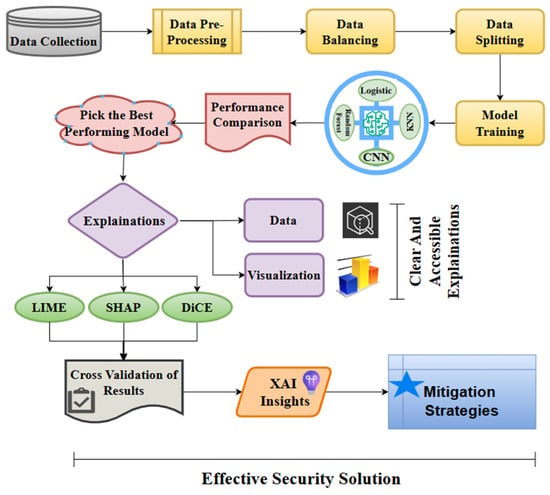
Figure 1.
The proposed explainable security framework.
3. Emerging Security Vulnerabilities in IoMT-Driven 6G Healthcare Scenarios
With the rapid evolution toward 6G, healthcare applications powered by the IoMT are set to become more intelligent, interconnected, and latency sensitive. As illustrated in Figure 2, some of these 6G usage scenarios are extensions of the 5G framework, while others, such as ubiquitous connectivity, native AI, and integrated sensing and communication, are entirely new scenarios. For further technical details, readers may refer to the ITU-R IMT-2030 framework [].
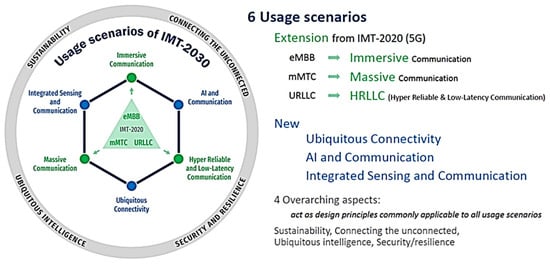
Figure 2.
The six usage scenarios for 6G (source: ITU-R M.2160).
While 6G advancements offer great potential for healthcare, they also create significant security challenges. Each usage scenario involves distinct operational dynamics that expose unique vulnerabilities. Figure 3 highlights these scenarios alongside associated threats such as data tampering, denial-of-service (DoS) attacks, latency manipulation, and AI poisoning [,,,]. These risks are particularly critical in IoMT-driven environments, where security breaches can quickly propagate and impact patient safety and care delivery.
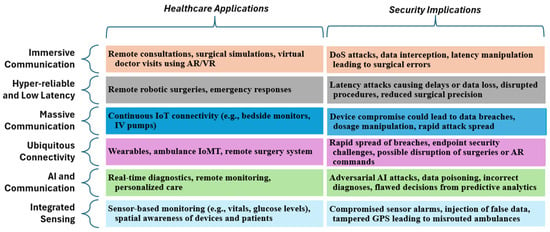
Figure 3.
Healthcare applications and security implications of 6G usage scenarios in IoMT environments.
As healthcare systems transition to fully connected, intelligent 6G environments, the increasing reliance on AI can hinder threat detection and strategic decision-making for risk management [,]. Integrating XAI is essential for ensuring transparency, building trust, and maintaining secure, resilient infrastructures []. In the following sections, we will discuss the methods, materials, experiments, and results, demonstrating how XAI contributes to developing effective mitigation strategies for 6G usage scenarios, ultimately enhancing security and system resilience.
4. Materials and Methods
The experiments were conducted using Python 3.10 in a Google Colab environment with GPU acceleration to enhance computational efficiency. TensorFlow (v2.17.1) and Keras (v3.5.0) were used for model development and training, while Matplotlib (v3.10.0) and Seaborn (v0.13.2) supported result visualization. This setup ensured efficient processing, robust model development, and clear visual insights—key for building trust and security in intelligent 6G networks.
For analysis, we used a comprehensive, publicly available dataset designed for security research in medical networks []. The dataset comprises 77 features across 145K samples—132K normal and 13K attack instances—capturing both network and host-based attributes. The testbed includes a core network, local network, multi-access edge computing (MEC) servers, user equipment (UE), and a routing system. To simulate realistic threat scenarios, tools like Simu5G and Stateful IP/ICMP Translation (SIIT) were integrated. The dataset highlights four major threats, each representing a critical security challenge in medical network environments, as shown in Figure 4:
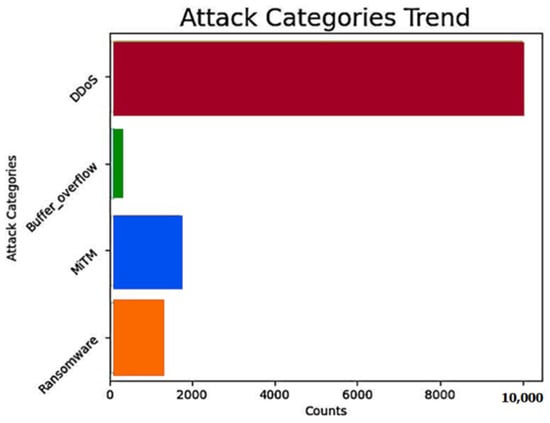
Figure 4.
Visualization plot of different class types and their counts.
- Man-in-the-Middle (MiTM): This attack involves intercepting and potentially modifying communications between two parties, thereby enabling unauthorized access to sensitive information.
- Distributed Denial-of-Service (DDoS): In this type of attack, adversaries inundate systems with excessive traffic, depleting resources and resulting in service disruptions or complete outages.
- Ransomware: A form of malicious software that encrypts critical organizational data and demands a ransom for its decryption, leading to significant disruption of routine operations.
- Buffer overflow: This attack exploits vulnerabilities in memory management to inject and execute malicious code, which can compromise the integrity and security of the system.
Although this dataset was originally designed for 5G, its structure and complexity make it highly suitable for evaluating AI-driven security frameworks in 6G environments. It aligns with the ITU-R IMT-2030 framework (M.2160) depicted in Figure 5, which envisions 6G as an evolution of 5G, incorporating both enhanced capabilities and entirely new features. Building on the foundation established by 5G, 6G introduces innovations such as native AI integration, sub-terahertz (THz) communication, reconfigurable intelligent surfaces (RISs), and integrated sensing and communication (ISAC), while also improving areas like spectrum efficiency, energy efficiency, and network resilience. This dataset is particularly relevant for evaluating the resilience and adaptability of security frameworks in the 6G context, as it includes critical network components such as routers, servers, and MEC nodes.
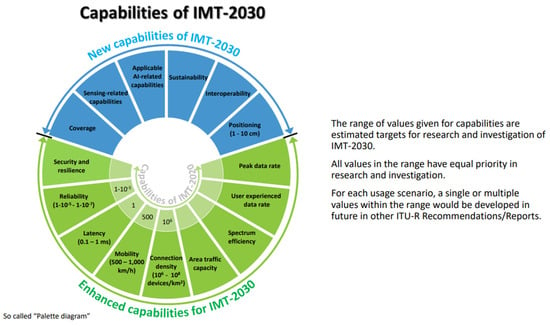
Figure 5.
The capabilities of IMT—2030 (source: ITU—R M.2160).
Moreover, the dataset simulates network conditions like high bandwidth, ultra-low latency, and diverse traffic scenarios, reflecting the core characteristics of 6G, particularly relevant for mission-critical healthcare applications such as robotic surgeries and AI-assisted diagnostics. It also incorporates security-specific data, such as traffic logs and simulated attack patterns, making it indispensable for 6G healthcare threat modeling. By addressing IPv6/IPv4 compatibility and including a range of cyber threats, including IoT-based attacks and network anomalies, it provides a solid foundation for developing and testing advanced security solutions for future wireless networks. Also, given the unavailability of 6G network data, this dataset remains the most reliable resource for evaluating potential security threats and developing mitigations, particularly in the context of healthcare applications in the forthcoming 6G era.
After data collection, we addressed class imbalances, especially in attack subclasses, using standard SMOTE []. SMOTE generates new minority instances using nearest neighbors, preserving key majority-class information without duplication. This approach generates synthetic instances by interpolating between a given minority class instance, , and one of its k nearest neighbors, . The new synthetic instance is computed as follows:
In Equation (1), is a randomly selected value from a uniform distribution in the range [0, 1]. This technique ensures that the synthetic data points are systematically positioned along the line segment connecting and , effectively enhancing the diversity of the minority class without simply duplicating the existing data.
The dataset was pre-processed for binary classification (attack vs. normal) and split into 80–20 ratio for training and testing purposes. Various machine learning models, including Logistic Regression [], Random Forest [], KNN [], and a CNN [], were evaluated to classify the network traffic. These models were selected for their distinct strengths: Logistic Regression for its simplicity and interpretability, Random Forest for its robustness to overfitting and ability to handle complex interactions, KNN for its effectiveness in non-linear data classification, and the CNN for its ability to automatically learn hierarchical features from raw data. Each model was chosen to provide a balanced comparison of performance.
To ensure model interpretability, XAI techniques were used to interpret the model’s decisions and to identify key factors that are influencing model predictions. These techniques are essential for building trust and accountability in cybersecurity applications. Specifically, SHAP quantifies the contribution of each feature to the model’s prediction, assigning specific values to each feature []. The value for feature in prediction is computed using the following formula:
In Equation (2), denotes the SHAP value for feature at instance , is the subset of the features excluding , denotes the number of features in the subset , is the number of ways to select subset , represents the total number of features, and is the model’s prediction function. This method provides a comprehensive explanation of how each feature affects the model’s decision.
The other XAI method, LIME, approximates the model’s prediction function locally around an instance x by minimizing a loss function []. This method enables the interpretation of complex models in the vicinity of a specific instance. The optimization problem is expressed as follows:
In Equation (3), denotes the interpretable model, represents the proximity measure around x, L is denoted as a loss function, and Ω(g) is a penalty term ensuring the complexity of g.
Also, the DiCE method generates multiple counterfactuals, or alternative explanations, for a model’s prediction, helping us to understand what changes could lead to a different outcome []. This process aids in uncovering the sensitivity of the model’s predictions to variations in the feature values. The objective of optimization for DiCE is to identify counterfactuals that are close to the original input, providing insights into the sensitivity of the model’s decisions. The optimization objective is as follows:
In Equation (4), is the original instance, ’ is the counterfactual instance, is the desired output, and is a loss function that ensures alignment with the target. The term ensures that the counterfactual instance is close to the original, while promotes variability among counterfactuals.
5. Experiments and Results
This section outlines the experimental setup and presents the performance results of the proposed models, including insights from the XAI techniques (SHAP, LIME, and DiCE) used to interpret the models’ decision-making processes.
5.1. Data PreProcessing and Splitting
The collected dataset [] was preprocessed into Pandas DataFrame [], addressing infinite and missing values, removing duplicates, converting categorical labels to numerical formats, and normalizing features. Features with zero variance were excluded, reducing the attribute count from 77 to 52, ensuring a suitable dataset for model training.
To address class imbalances and reduce biases, we applied the standard SMOTE, standardizing each attack subclass to match the sample size of the normal class, as shown in Figure 6a. This balancing improved the model’s ability to generalize and enhanced the classification accuracy. The problem was reformulated as a binary classification task to distinguish between malicious (attack) and non-malicious (normal) network traffic, aiming to identify attacks accurately. Figure 6b shows the balanced distribution of the two classes—normal (0) and attack (1)—improving the model’s reliability in real-world network security applications.
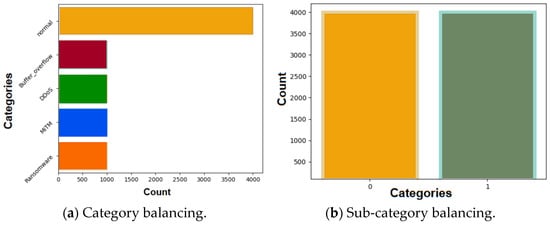
Figure 6.
Visualization of class categories and their counts after using SMOTE.
Given the size of the dataset, we randomly selected 4000 records from each class (normal and attack traffic) for model evaluation. This subset enables us to effectively apply and evaluate XAI techniques while maintaining computational efficiency, aligning with our primary objective of developing interpretable and transparent models to enhance network security, rather than focusing solely on maximizing model performance across the full dataset. Table 1 presents the sample distribution before and after applying SMOTE, which was used to balance the dataset. Achieving this balance is essential for accurate threat detection and consistent model performance in realistic 6G network scenarios.

Table 1.
Dataset categorization.
5.2. Model Training
The models—Logistic Regression, Random Forest, KNN, and a CNN—were trained and evaluated on the same post-SMOTE dataset using key metrics, with the results summarized in Table 2 for reproducibility:

Table 2.
Performance evaluation metrics.
- Logistic Regression: The model is configured with random_state = 7 to ensure consistent results, max_iter = 5000 to allow sufficient iterations for convergence, solver = ‘lbfgs’ for efficient optimization using limited-memory BFGS, and class_weight = ‘balanced’ to automatically adjust for class imbalances in the dataset.
- CNN: The architecture consists of dense layers with 120, 80, 40, and 20 neurons, followed by a single-neuron output layer. It utilizes a batch size of 10 and the Adam optimizer for adaptive learning rate adjustments and is trained for 100 epochs to ensure convergence and minimize loss.
- Random Forest: The model uses n_estimators = 100 decision trees, with random_state = 42 sets to ensure the reproducibility of results across different runs by maintaining the same random state in the training process.
- KNN: The model is initialized with default hyperparameters, and random_state = 42 ensures consistent results in the training and evaluation process by controlling the randomization.
While further tuning could enhance accuracy, the focus remains on interpretability through XAI techniques—essential for informed security decisions, detecting vulnerabilities, and ensuring robust protection in future 6G networks.
5.3. Model Selection for XAI Technique Application
Given its strong performance, the Random Forest model was prioritized, and XAI techniques—SHAP, LIME, and DiCE—were used to interpret its decision-making. While Random Forest provides some level of interpretability through built-in feature importance, it still behaves like black box models in high-dimensional scenarios. XAI techniques help to uncover complex feature interactions and offer instance-level explanations, thereby improving transparency in healthcare security. Figure 7 presents the feature importance plot generated by the Random Forest model using the scikit-learn Python library []. Among the features, ‘scputimes_idle’ holds the highest importance, followed by ‘scputimes_user’ and ‘scpustats_interrupts’. Features that were assigned to zero importance have been excluded from the plot, as they do not contribute to the model’s predictive performance.
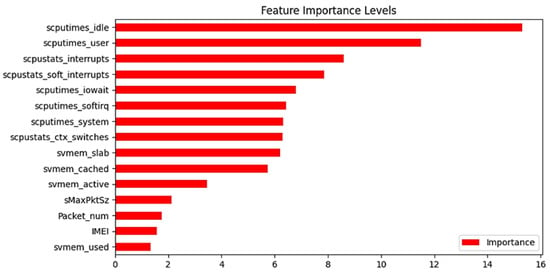
Figure 7.
Feature importance plot for Random Forest.
5.4. Implementation of Explainable AI Techniques: SHAP, LIME, and DiCE
To illustrate the decision-making process of the selected model, we analyzed a random test sample from the post-SMOTE dataset to assess how specific features impact the final classification (‘Normal’ or ‘Attack’). This analysis highlights the key factors influencing the model’s decisions, improving transparency and supporting ongoing refinement to ensure adaptability to the evolving security challenges in 6G network environments.
5.4.1. SHAP–Global Behavior Analysis
The SHAP global plot identifies the features with the greatest influence on classifying an instance as either an attack or normal, providing insights into the model’s overall behavior. Figure 8 visualizes the impact of each feature on the model’s predictions across all instances, with blue representing Class 1 (attack) and red representing Class 0 (normal). The balanced distribution of blue and red lines for each feature indicates that the model considers both attack and normal instances, showing that its decision-making process is influenced by patterns in both classes.
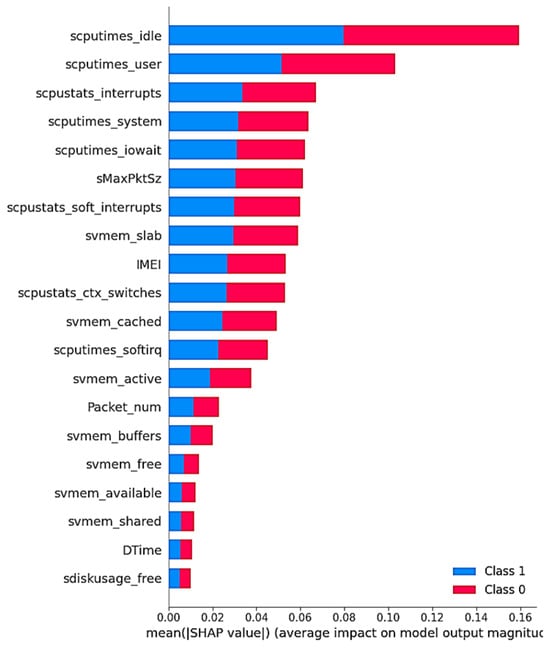
Figure 8.
SHAP force plot.
5.4.2. SHAP—Local Behavior Analysis
The SHAP global summary plot shows overall feature importance but doesn’t explain individual predictions. This highlights the need for local interpretability which is provided by the SHAP force plot. This plot visually provides instance-specific insights, enhancing interpretability and trust in AI-driven security and healthcare applications. The plot employs the following:
- Red indicates positive contributions (pushing prediction higher), increasing the likelihood of the predicted class.
- Blue represents negative contributions (pulling prediction lower), usually decreasing the likelihood of the predicted class, favoring the opposite prediction.
- The width of each bar reflects the magnitude of the feature’s influence, with wider bars indicating a stronger effect.
- It starts with the base value (average model output) and accumulates feature contributions to display the final prediction at the end.
- 1.
- SHAP Force Plot for Test Sample Record 1—‘Normal’ Traffic Prediction
Figure 9 shows the SHAP force plot for sample record 1, highlighting how individual features influenced the model’s prediction. The actual target is labeled as “Normal”, meaning that in the dataset, this instance is truly a non-attack instance. The model’s prediction output (f(x) = 1.00) suggests that the model classified this instance as not an attack.

Figure 9.
SHAP force plot for record sample 1 from test dataset (local explanation)—predicting Class 0—“Normal” traffic.
Table 3 lists the key features from the SHAP force plot that contribute to the “Normal” traffic prediction. It includes feature descriptions, their roles in the model’s decisions, and how specific values support the classification as non-attack traffic.

Table 3.
SHAP force plot for normal traffic classification.
- 2.
- SHAP Force Plot for Test Sample Record 2—‘Attack’ Traffic Prediction
The SHAP force plot for sample record 2 from the testing dataset, with a base value of 0.50 and a final prediction of ‘Attack’, is shown in Figure 10. The model’s final prediction of 0.00, which is notably lower than that of the base value, indicates that the feature values substantially decreased the model’s confidence in classifying the instance as an attack. The primary features (depicted in blue) are contributing to this reduction in the prediction value, thereby decreasing the likelihood of the event being classified as an attack. The following observations can be made:

Figure 10.
SHAP force plot for record sample 2 from test dataset (local explanation)—predicting Class 1–“Attack” traffic.
- The actual target is labeled as “Attack”, meaning that in the dataset, this instance is truly an attack.
- The model’s prediction output (f(x) = 0.00) suggests that the model classified this instance as not an attack (likely normal or benign traffic).
- The cumulative effect of these features outweighs the benign contributions of others, leading the model to classify the prediction as an attack. For instance, high system resource usage (user, I/O wait time, and system-level processes) and interrupts (hardware and software) indicate a pattern of abnormal activity that is typical of an attack (e.g., DDoS, resource exhaustion, or other malicious behaviors).
Table 4 lists the features, their interpretations, and the contributions to the model’s prediction, explaining why the prediction is classified as an attack. While some features suggest normal behavior, their individual contributions are insufficient to change the decision. However, the combined influence of certain features, in context, leads to the classification of an attack, highlighting the complex interplay of feature contributions in the decision-making process.

Table 4.
Feature contributions and interpretations in SHAP force plot for network traffic classification.
5.4.3. LIME—Local Behavior Analysis
LIME are divided into three sections with a consistent color scheme:
- The left shows the model’s predicted probability for the instance.
- The middle section shows key features: blue for benign (0), orange for attack (1). Bar length reflects feature impact, with longer bars indicating greater influence.
- The right section shows actual feature values. The features highlighted in blue contribute negatively to the prediction and the features highlighted in orange contribute positively to the prediction.
- 1.
- LIME Plot for Test Sample Record 1—‘Normal’ Traffic Prediction
Figure 11 illustrates a LIME for the “Normal” class instance. The following conclusions can be drawn:
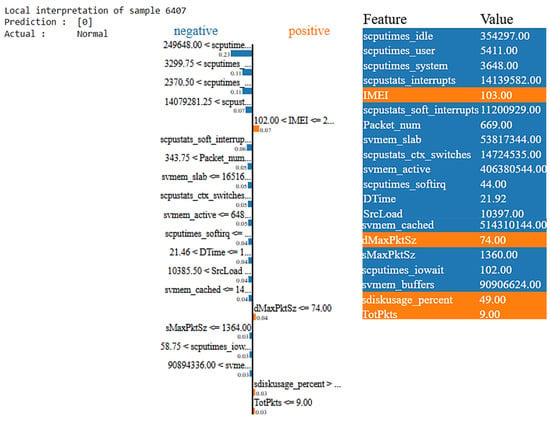
Figure 11.
LIME plot for record sample 1 from test dataset (local explanation)—predicting Class 0—“Normal” traffic.
- Although several features contribute negatively (blue) in the LIME plot, the prediction is still classified as “Normal” because the model evaluates the overall interactions of all features rather than assessing them individually.
- The positively contributing features (orange), such as dMaxPktSz, IMEI, and TotPkts, help to counterbalance the negative influences, leading to the final classification.
Table 5 highlights the features and their contributions to the classification of network traffic as “Normal”, based on the LIME plot, with interpretations of the feature values and the reasons for their positive or negative influence on the final prediction.

Table 5.
LIME-based feature contribution analysis in normal prediction.
- 2.
- LIME Plot Test Sample Record 2—‘Attack’ Traffic Prediction
Figure 12 presents the LIME plot for test record 2, with the prediction of “Attack”. The plot illustrates how different features influence the model’s prediction.
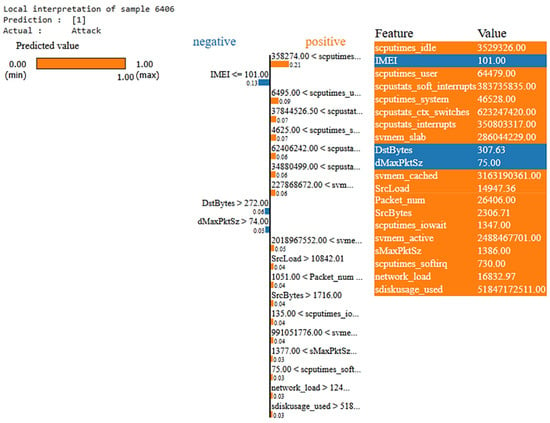
Figure 12.
LIME plot for record sample 1 from test dataset (local explanation)—predicting Class 1—“Attack” traffic.
- The blue features (IMEI, DstBytes and dMaxPktSz) contribute slightly towards a benign classification, as they do not exhibit strong attack characteristics. Their presence slightly reduces the likelihood of an attack but does not override the dominant attack-related features.
- The orange features dominate the decision, reflecting the abnormal CPU, memory, network, and disk behaviors commonly associated with attacks.
Table 6 effectively summarizes how LIME interprets the feature contributions in determining the final prediction.

Table 6.
LIME-based feature contribution analysis for attack classification.
5.4.4. DiCE—Local Behavior Analysis
The DiCE is illustrated in Figure 13, where the top row displays the original sample with a prediction of ‘1’ (indicating “Attack”). The bottom row presents three counterfactual scenarios, each with a prediction of ‘0’ (indicating “Normal”).

Figure 13.
DiCE visualization of feature values and counterfactual instances.
From this, the following conclusions can be drawn:
- The combination of high traffic volume (SrcBytes, DstBytes), elevated system load (SrcLoad, DstLoad), and network instability (SrcJitter, DstJitter) indicates an anomalous network condition. These feature values typically suggest an ongoing attack, such as a DDoS attack, characterized by excessive data flow and network disruptions.
- The counterfactual examples state “normal” traffic due to significant reductions in traffic volume and jitter. Lower values for SrcBytes and DstBytes indicate typical network behavior with normal data flow, while the reduced SrcJitter and DstJitter suggest stable network conditions, which are characteristics of non-attack traffic patterns.
- Some values are marked with ‘-’, indicating that these features were not altered in the counterfactual examples.
Table 7 shows the features identified via DiCE that contribute to the attack prediction, highlighting their influence on the model’s decision. It details how changes in feature values affect the classification, offering insights into the factors driving the shift from normal to attack behavior.

Table 7.
List of features identified via DiCE that contribute to attack prediction.
Table 8 presents the features identified via DiCE and their counterfactual values that shift the prediction from attack to normal. It highlights the key features influencing the model’s decision and shows the necessary changes to alter the classification outcome, providing insights into the decision boundaries of the predictive model.

Table 8.
List of features identified via DiCE that contribute to normal prediction.
By analyzing DiCE features, key indicators such as traffic volume, system load, and network stability effectively distinguish between normal and attack scenarios. In 6G networks, with higher data rates and extensive device connectivity, these factors become critical for identifying security threats. A reduction in abnormal traffic volumes and network instability—indicated by lower SrcBytes and DstBytes and more stable SrcJitter and DstJitter—signals a stable, non-malicious network state, ensuring secure communication in 6G’s high-speed environment. This analysis supports proactive risk monitoring, enhances response times, and optimizes resource allocation during security events.
6. Cross-Validation Results of XAI Methods
This section evaluates various XAI techniques, specifically, SHAP, LIME and DiCE, using cross-validation to assess their contributions to securing healthcare application within 6G environments. The analysis emphasizes the consistency and interpretability of feature importance across different XAI methods to improve transparency, trust, and robustness in AI-driven security systems for healthcare.
The interpretability analysis with SHAP, LIME, and DiCE offers critical insights into decision-making, enhancing the model’s reliability in distinguishing normal from attack traffic. SHAP associate high system time (‘scputimes_system’), user time (‘scputimes_user’), and idle time (‘scputimes_idle’) with normal operations, whereas LIME warn that excessive idle time (‘scputimes_idle’) may indicate underutilization, potentially masking malicious activity, and high user time (‘scputimes_user’) could signal cryptojacking or resource-intensive attacks. This suggests that while CPU activity is a strong indicator of normal behavior, extreme deviations can imply anomalies. In network activity, DiCE identify source bytes (‘SrcBytes’) and destination bytes (‘DstBytes’) as indicators of normal traffic, with unusually high values signaling potential data exfiltration or flooding. Similarly, low source jitter (‘SrcJitter’) and destination jitter (‘DstJitter’) support a normal prediction, while high jitter suggests network instability or an attack, aligning with LIME’ identification of unusual packet activity (‘SIntPktAct’) as a threat. Regarding system resource availability, LIME highlight available virtual memory (‘svmem_free’) and minimum packet size (‘sMinPktSz’) as stabilizing factors in normal predictions, complementing SHAP and DiCE, which focus more on CPU and network metrics. This cross-validation confirms that normal traffic is characterized by stable CPU usage, typical network activity, and sufficient resources, while anomalies in idle time (‘scputimes_idle’), jitter (‘SrcJitter’, ‘DstJitter’), and unusual packet behavior (‘SIntPktAct’) indicate potential attacks. This empirical analysis illustrates how a comprehensive, multi-faceted approach strengthens the security framework of 6G-enabled healthcare systems.
This evaluation confirms the reliability of explainability, showing that the identified features genuinely influence model predictions, not just artifacts of a specific method. The consistency across XAI techniques reinforces the trustworthiness of AI-driven decisions in critical applications, such as 6G medical network security, strengthening confidence in the transparency and dependability of the approach.
7. Mitigation Strategies in IoMT-Driven 6G Usage Scenarios
XAI insights play a vital role in enhancing the security of 6G-enabled medical IoT systems by transparently identifying critical features that influence both performance and potential vulnerabilities [,]. In Table 9, we analyzed various 6G usage scenarios with the help of XAI methods, which allowed us to identify key features contributing to both attack and non-attack behaviors. XAI techniques revealed which specific features influenced security outcomes—highlighting whether a high or low value of a given feature was associated with malicious or normal activity. By mapping these feature-based insights onto the functional requirements of each 6G usage scenario, we were able to pinpoint potential threats relevant to that scenario. Based on this analysis, we proposed targeted mitigation strategies aligned with the critical system behaviors and security risks of each use case. Furthermore, we presented XAI-driven security enhancements that empower security administrators to extract actionable insights and implement precise, scenario-specific measures—ensuring robust protection tailored to the unique demands of each 6G medical IoT use case.

Table 9.
Mitigation strategies and security improvements for 6G usage scenarios based on XAI insights.
Understanding the security implications of these attacks will help to safeguard emerging 6G technologies—ensuring resilient, safe, and intelligent healthcare systems in the future.
8. Conclusions
The convergence of advanced wireless communication and healthcare technologies presents significant risks to the integrity of sensitive patient data and the performance of medical applications. As the transition to 6G accelerates, the increased integration of virtualization, extended reality, intelligent sensing, and AI into communication frameworks expands the attack surface, increasing risks to patient data integrity and the reliability of life-critical medical applications. Left unaddressed, these emerging threats could result in severe service disruptions and potential catastrophic outcomes in clinical environments. While AI is instrumental in detecting and mitigating complex security threats, its inherent black box nature can hinder transparency, making it difficult for security teams to fully understand and trust automated decisions. This limitation highlights the necessity of XAI in the context of 6G-enabled healthcare systems.
Our research highlights the crucial role of XAI in closing the explainability gap in AI-driven security systems. By integrating SHAP, LIME, and DiCE, we propose a comprehensive framework that demystifies model decisions and makes security insights both interpretable and actionable for technical and non-technical audiences alike. This multi-perspective analysis enhances the understanding of model behavior, enabling more adaptive and informed security responses. Our approach not only reinforces the consistency and dependability of XAI-based assessments but also underlines the significance of explainability in fostering trust in AI systems, particularly in sensitive and high-stakes environments.
As healthcare systems advance toward 6G connectivity, the reliability and security of AI-powered medical technologies will be essential for delivering intelligent, timely, and safe patient care. This study supports that goal by contributing to the development of secure, transparent, and adaptive AI models, specifically designed for integration into next-generation healthcare infrastructure. Future work will focus on incorporating datasets specific to 6G, either original or simulated, instead of using 5G-originated datasets, and exploring more advanced models tailored to 6G networks to further enhance the robustness and scalability of AI-based security systems in these evolving environments.
Author Contributions
Conceptualization, L.G. and N.K.; Methodology, L.G. and N.K.; Software, N.K.; Validation, L.G. and N.K.; Formal analysis, N.K.; Investigation, N.K.; Resources, L.G. and N.K.; Data curation, N.K.; Writing—original draft, N.K.; Writing—review & editing, L.G.; Visualization, N.K.; Supervision, L.G.; Project administration, L.G. and N.K.; Funding acquisition, L.G. All authors have read and agreed to the published version of the manuscript.
Funding
This research received no external funding.
Data Availability Statement
The original contributions presented in this study are included in the article. Further inquiries can be directed to the corresponding author.
Conflicts of Interest
The authors declare no conflict of interest.
References
- Shen, Y.T.; Chen, L.; Yue, W.W.; Xu, H.X. Digital technology-based telemedicine for the COVID-19 pandemic. Front. Med. 2021, 8, 646506. [Google Scholar] [CrossRef] [PubMed]
- Osama, M. Internet of medical things and healthcare 4.0: Trends, requirements, challenges, and research directions. Sensors 2023, 23, 7435. [Google Scholar] [CrossRef] [PubMed]
- Yaqoob, T.; Abbas, H.; Atiquzzaman, M. Security vulnerabilities, attacks, countermeasures, and regulations of networked medical devices—A review. IEEE Comst 2019, 21, 3723–3768. [Google Scholar] [CrossRef]
- Framework and Overall Objectives of the Future Development of IMT for 2030 and Beyond. Available online: https://www.itu.int/dms_pubrec/itu-r/rec/m/R-REC-M.2160-0-202311-I%21%21PDF-E.pdf (accessed on 11 July 2024).
- Ghubaish, A.; Yang, Z.; Jain, R. HDRL-IDS: A Hybrid Deep Reinforcement Learning Intrusion Detection System for Enhancing the Security of Medical Applications in 5G Networks. In Proceedings of the 2024 International Conference on Smart Applications, Communications and Networking (SmartNets), Harrisonburg/Washington, DC, USA, 28–30 May 2024; pp. 1–6. [Google Scholar]
- Hossain, M.S.; Muhammad, G.; Guizani, N. Explainable AI and mass surveillance system-based healthcare framework to combat COVID-I9 like pandemics. IEEE Netw. 2020, 34, 126–132. [Google Scholar] [CrossRef]
- Dave, D.; Naik, H.; Singhal, S.; Patel, P. Explainable ai meets healthcare: A study on heart disease dataset. arXiv 2020, arXiv:2011.03195. [Google Scholar]
- Bárcena, J.L.C.; Ducange, P.; Marcelloni, F.; Nardini, G.; Noferi, A.; Renda, A.; Ruffini, F.; Schiavo, A.; Stea, G.; Virdis, A. Enabling federated learning of explainable AI models within beyond-5G/6G networks. Comput. Commun. 2023, 210, 356–375. [Google Scholar] [CrossRef]
- Mohanty, S.D.; Lekan, D.; Jenkins, M.; Manda, P. Machine learning for predicting readmission risk among the frail: Explainable AI for healthcare. Patterns 2022, 3, 100395. [Google Scholar] [CrossRef]
- Nguyen, V.L.; Lin, P.C.; Cheng, B.C.; Hwang, R.H.; Lin, Y.D. Security and privacy for 6G: A survey on prospective technologies and challenges. IEEE Commun. Surv. Tutor. 2021, 23, 2384–2428. [Google Scholar] [CrossRef]
- Kaur, N.; Gupta, L. Securing the 6G–IoT Environment: A Framework for Enhancing Transparency in Artificial Intelligence Decision-Making Through Explainable Artificial Intelligence. Sensors 2025, 25, 854. [Google Scholar] [CrossRef]
- Musa, A. History of security and privacy in wireless communication systems: Open research issues and future directions. In Security and Privacy Schemes for Dense 6G Wireless Communication Networks; The Institution of Engineering and Technology: Stevenage, UK, 2023; pp. 31–60. [Google Scholar] [CrossRef]
- Xiao, Y.; Jia, Y.; Liu, C.; Cheng, X.; Yu, J.; Lv, W. Edge computing security: State of the art and challenges. Proc. IEEE 2019, 107, 1608–1631. [Google Scholar] [CrossRef]
- Deng, J.; Han, R.; Mishra, S. Decorrelating wireless sensor network traffic to inhibit traffic analysis attacks. Pervasive Mob. Comput. 2006, 2, 159–186. [Google Scholar] [CrossRef]
- Wang, S.; Parsons, M.; Stone-McLean, J.; Rogers, P.; Boyd, S.; Hoover, K.; Meruvia-Pastor, O.; Gong, M.; Smith, A. Augmented reality as a telemedicine platform for remote procedural training. Sensors 2017, 17, 2294. [Google Scholar] [CrossRef]
- Newaz, A.I.; Sikder, A.K.; Rahman, M.A.; Uluagac, A.S. A survey on security and privacy issues in modern healthcare systems: Attacks and defenses. ACM Trans. Comput. Healthc. 2021, 2, 27. [Google Scholar] [CrossRef]
- Lundberg, S.M.; Lee, S.I. A unified approach to interpreting model predictions. Adv. Neural Inf. Process. Systems 2017, 30. [Google Scholar]
- Ribeiro, M.T.; Singh, S.; Guestrin, C. “Why should i trust you?” Explaining the predictions of any classifier. In Proceedings of the 22nd ACM SIGKDD International Conference on Knowledge Discovery and Data Mining, San Francisco, CA, USA, 13–17 August 2016; pp. 1135–1144. [Google Scholar]
- Mothilal, R.K.; Sharma, A.; Tan, C. Explaining machine learning classifiers through diverse counterfactual explanations. In Proceedings of the 2020 Conference on Fairness, Accountability, and Transparency, Barcelona, Spain, 27–29 January 2020; pp. 607–617. [Google Scholar]
- Amin, A.; Hasan, K.; Zein-Sabatto, S.; Chimba, D.; Ahmed, I.; Islam, T. An explainable ai framework for artificial intelligence of medical things. In Proceedings of the IEEE Globecom Workshops (GC Wkshps), Kuala Lumpur, Malaysia, 4–8 December 2023; pp. 2097–2102. [Google Scholar]
- Sai, S.; Sharma, S.; Chamola, V. Explainable ai-empowered neuromorphic computing framework for consumer healthcare. IEEE Trans. Consum. Electron. 2024. [Google Scholar] [CrossRef]
- Gürbüz, E.; Turgut, O.; Kök, I. Explainable ai-based malicious traffic detection and monitoring system in next-gen iot healthcare. In Proceedings of the 2023 International Conference on Smart Applications, Communications and Networking (SmartNets), Istanbul, Türkiye, 25–27 July 2023; pp. 1–6. [Google Scholar]
- Alani, M.M.; Mashatan, A.; Miri, A. Explainable Ensemble-Based Detection of Cyber Attacks on Internet of Medical Things. In Proceedings of the 2023 IEEE Intl Conf on Dependable, Autonomic and Secure Computing, Intl Conf on Pervasive Intelligence and Computing, Intl Conf on Cloud and Big Data Computing, Intl Conf on Cyber Science and Technology Congress (DASC/PiCom/CBDCom/CyberSciTech), Abu Dhabi, United Arab Emirates, 13–17 November 2023; pp. 0609–0614. [Google Scholar]
- Alani, M.M.; Mashatan, A.; Miri, A. XMeDNN: An Explainable Deep Neural Network System for Intrusion Detection in Internet of Medical Things. In Proceedings of the 9th International Conference on Information Systems Security and Privacy (ICISSP 2023), Lisbon, Portugal, 22–24 February 2023; pp. 144–151. [Google Scholar]
- Raza, A.; Tran, K.P.; Koehl, L.; Li, S. Designing ECG monitoring healthcare system with federated transfer learning and explainable AI. Knowl.-Based Syst. 2022, 236, 107763. [Google Scholar] [CrossRef]
- Chawla, N.V.; Bowyer, K.W.; Hall, L.O.; Kegelmeyer, W.P. SMOTE: Synthetic minority over-sampling technique. J. Artif. Intell. Res. 2002, 16, 321–357. [Google Scholar] [CrossRef]
- Nasralla, M.M.; Khattak, S.B.A.; Rehman, I.U.; Iqbal, M. Exploring the role of 6G technology in enhancing quality of experience for m-health multimedia applications: A comprehensive survey. Sensors 2023, 23, 5882. [Google Scholar] [CrossRef]
- Wood, A.D.; Stankovic, J.A. A taxonomy for denial-of-service attacks in wireless sensor networks. In Handbook of Sensor Networks: Compact Wireless and Wired Sensing Systems; CRC Press: Boca Raton, FL, USA, 2004; Volume 4, pp. 739–763. [Google Scholar]
- Kaur, N.; Gupta, L. An approach to enhance iot security in 6g networks through explainable ai. arXiv 2024, arXiv:2410.05310. [Google Scholar]
- Kaur, N.; Gupta, L. Enhancing IoT Security in 6G Environment With Transparent AI: Leveraging XGBoost, SHAP and LIME. In Proceedings of the 2024 IEEE 10th NetSoft, Saint Louis, MO, USA, 24–28 June 2024; pp. 180–184. [Google Scholar]
- Cramer, J.S. The Origins of Logistic Regression; Social Science Research Network: Rochester, NY, USA, 2002. [Google Scholar]
- Biau, G.; Scornet, E. A random forest guided tour. Test 2016, 25, 197–227. [Google Scholar] [CrossRef]
- Peterson, L.E. K-nearest neighbor. Scholarpedia 2009, 4, 1883. [Google Scholar] [CrossRef]
- Wu, J. Introduction to convolutional neural networks. Natl. Key Lab Nov. Softw. Technol. Nanjing Univ. China 2017, 5, 495. [Google Scholar]
- Pandas. Dataframe. Available online: https://pandas.pydata.org/docs/reference/api/pandas.DataFrame.html (accessed on 2 February 2024).
- Permutation Importance vs. Random Forest Feature Importance (MDI). Available online: https://scikit-learn.org/stable/auto_examples/inspection/plot_permutation_importance.html#sphx-glr-auto-examples-inspection-plot-permutation-importance-py (accessed on 26 March 2024).
- Ramamoorthi, V. Exploring AI-Driven Cloud-Edge Orchestration for IoT Applications. Int. J. Sci. Res. Comput. Sci. Eng. Inf. Technol. 2023, 9, 385–393. [Google Scholar] [CrossRef]
- Adele, G.; Borah, A.; Paranjothi, A.; Khan, M.S.; Poulkov, V.K. A Comprehensive Systematic Review of Blockchain-based Intrusion Detection Systems. In Proceedings of the 2024 IEEE World AI IoT Congress (AIIoT), Melbourne, Australia, 24–26 July 2024; pp. 605–611. [Google Scholar]
- El-Hajj, M. Enhancing Communication Networks in the New Era with Artificial Intelligence: Techniques, Applications, and Future Directions. Network 2025, 5, 1. [Google Scholar] [CrossRef]
- Paulsen, S.; Uhl, T.; Nowicki, K. Influence of the jitter buffer on the quality of service VoIP. In Proceedings of the 2011 3rd International Congress on Ultra Modern Telecommunications and Control Systems and Workshops (ICUMT), Budapest, Hungary, 5–7 October 2011; pp. 1–5. [Google Scholar]
- Sharma, H. Behavioral Analytics and Zero Trust. Int. J. Comput. Eng. Technol. 2021, 12, 63–84. [Google Scholar]
- Quattrociocchi, W.; Caldarelli, G.; Scala, A.A. Self-healing networks: Redundancy and structure. PLoS ONE 2014, 9, e87986. [Google Scholar] [CrossRef]
Disclaimer/Publisher’s Note: The statements, opinions and data contained in all publications are solely those of the individual author(s) and contributor(s) and not of MDPI and/or the editor(s). MDPI and/or the editor(s) disclaim responsibility for any injury to people or property resulting from any ideas, methods, instructions or products referred to in the content. |
© 2025 by the authors. Licensee MDPI, Basel, Switzerland. This article is an open access article distributed under the terms and conditions of the Creative Commons Attribution (CC BY) license (https://creativecommons.org/licenses/by/4.0/).